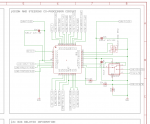Dear all,
I have been able to avoid the confusing topic of OpAmps for years. Now I thought it was time to get the confusion out of the way and my linear ccd sensor signal seems to be the right thing to play with.
If you recall from other threads, I was able to achieve about 0.2V output difference between black and white surface signals with good repeatability. I believe it would not be so wrong to call this amplitude for our case. As some of you have noted, this is not much and increasing the amplitude would be desirable. I have not been able to achieve this with extra lighting, clock speeds and integration time in the span available with picaxe. While I have a solution that works anyway with internal comparator in a constant light situation, almost non existent hysteresis allowance means that it requires a lot of calibration to be accurate in changing ambient lighting, which is not trivial if not impossible to do flawlessly.
So, I read up a little bit and what I read on the internet seemed to confirm my idea that an OpAmp can help to increase the amplitude of such signal. I set up a circuit in LTSpice to my best understanding, but all I can achieve is a gain of approx 1.5x. While this is an improvement, it is hardly worth the extra PCB space. Some images attached. What am I doing wrong? Or otherwise - where are the hundreds of times of gain possibility?

Thank you all for your time,
Edmunds
P.S. Blue is the input signal at "+" of the OpAmp, green is the amplified (and shifted) signal.
I have been able to avoid the confusing topic of OpAmps for years. Now I thought it was time to get the confusion out of the way and my linear ccd sensor signal seems to be the right thing to play with.
If you recall from other threads, I was able to achieve about 0.2V output difference between black and white surface signals with good repeatability. I believe it would not be so wrong to call this amplitude for our case. As some of you have noted, this is not much and increasing the amplitude would be desirable. I have not been able to achieve this with extra lighting, clock speeds and integration time in the span available with picaxe. While I have a solution that works anyway with internal comparator in a constant light situation, almost non existent hysteresis allowance means that it requires a lot of calibration to be accurate in changing ambient lighting, which is not trivial if not impossible to do flawlessly.
So, I read up a little bit and what I read on the internet seemed to confirm my idea that an OpAmp can help to increase the amplitude of such signal. I set up a circuit in LTSpice to my best understanding, but all I can achieve is a gain of approx 1.5x. While this is an improvement, it is hardly worth the extra PCB space. Some images attached. What am I doing wrong? Or otherwise - where are the hundreds of times of gain possibility?

Thank you all for your time,
Edmunds
P.S. Blue is the input signal at "+" of the OpAmp, green is the amplified (and shifted) signal.




